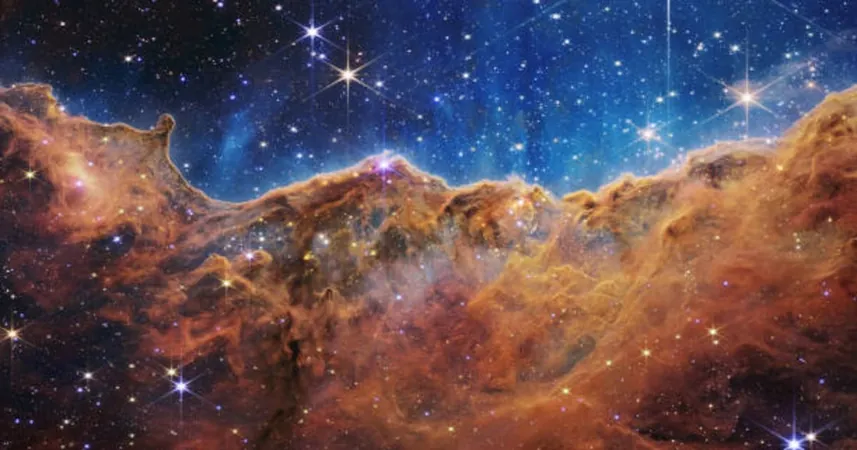
Discover the Secrets of the Universe: The James Webb Telescope at L2
2025-05-15
Author: Wei Ling
Unlocking the Mysteries of the Cosmos
Prepare to be amazed as we dive into the cosmic capabilities of the James Webb Space Telescope (JWST), the ultimate successor to the iconic Hubble Space Telescope. Positioned strategically at Lagrange Point 2 (L2), Webb offers astronomers an unrivaled view of the universe, free from Earth's obstructive grasp.
What Are Lagrange Points?
Imagine five celestial sweet spots across the solar system where spacecraft can dance in harmony with the Earth as they journey around the Sun. These are known as Lagrange points, named after the genius French mathematician Joseph-Louis Lagrange who tackled the complex "three-body problem." The second point, L2, lies about 150 million kilometers from the Sun, and guess what? It allows JWST to maintain perfect synchrony with Earth.
The Power of L2: Why It Matters
At L2, the gravitational forces of the Sun and Earth work together, allowing Webb to orbit comfortably while remaining aligned with our planet. This unique positioning ensures faster communication and higher data volumes as the telescope collects groundbreaking observations.
Webb vs. Hubble: A New Era of Discovery
While Hubble has dazzled us for over 35 years with stunning images and vital astronomical discoveries, including the universe's accelerating expansion, Webb elevates this quest for knowledge to new heights. Launched on Christmas Day 2021, this revolutionary telescope is situated 1.5 million kilometers beyond Earth, delivering a pristine, unobstructed view of the cosmos.
Infrared Vision: Peering Further into Space
Equipped to observe in the infrared spectrum, JWST can spot objects that are 100 times fainter than anything Hubble could see. Its primary mission? To unravel the formation and evolution of the first galaxies post-Big Bang, explore star and planetary system formation, and even dig deep into the origins of life itself.
Technological Marvels: Mirror and Orbit
With a gigantic 6.5-meter gold-plated mirror composed of 18 hexagonal segments, Webb dwarfs Hubble's capabilities. Yet, to maintain its ideal viewing conditions, Webb is placed in a clever halo orbit around L2, avoiding the shadows of Earth and the Moon. This design guarantees uninterrupted solar power and keeps the telescope's instruments at a chilly 50 Kelvin (that's minus 223 degrees Celsius!), essential for accurate infrared observations.
The Journey to L2: How It Works
Getting Webb to L2 was no small feat—think of it as the equivalent of cycling hard uphill to coast seamlessly to the top. While objects at L2 sit in a delicate balance of gravitational forces, drift can occur. Luckily, Webb requires minimal energy to maintain its position, allowing it to stay aligned with Earth as they move through space together.
A Long-Lasting Legacy
With hopes of operating for over 20 years, the James Webb Space Telescope promises to redefine our understanding of the universe. It's set to unlock new facets of cosmic history and possibly even shine light on life beyond our solar system. Buckle up—we're on the brink of astronomical adventures like never before!



 Brasil (PT)
Brasil (PT)
 Canada (EN)
Canada (EN)
 Chile (ES)
Chile (ES)
 Česko (CS)
Česko (CS)
 대한민국 (KO)
대한민국 (KO)
 España (ES)
España (ES)
 France (FR)
France (FR)
 Hong Kong (EN)
Hong Kong (EN)
 Italia (IT)
Italia (IT)
 日本 (JA)
日本 (JA)
 Magyarország (HU)
Magyarország (HU)
 Norge (NO)
Norge (NO)
 Polska (PL)
Polska (PL)
 Schweiz (DE)
Schweiz (DE)
 Singapore (EN)
Singapore (EN)
 Sverige (SV)
Sverige (SV)
 Suomi (FI)
Suomi (FI)
 Türkiye (TR)
Türkiye (TR)
 الإمارات العربية المتحدة (AR)
الإمارات العربية المتحدة (AR)